WASHINGTON -- National polls on the Republican presidential race have ridden the roller coaster this year. The ups and downs have been dizzying, but the root cause is fairly straightforward: Because most Republicans have not made up their minds yet, the preferences expressed to pollsters are mostly a reflection of news coverage. Candidates receiving a lot of coverage have seen their polling numbers rise, but when the media move on to another story, that support quickly fades.
This is the message emerging from new data on media coverage gathered by the Pew Research Center's Project for Excellence in Journalism and released on Monday in a report on how news media and blogs have covered the campaign.
The national Republican poll numbers have certainly been volatile, as illustrated by the HuffPost Pollster chart below, which combines results from all available public polls. Support for Minnesota Rep. Michele Bachmann shot up in July, then faded. Texas Gov. Rick Perry surged ahead of former Massachusetts Gov. Mitt Romney into first place in September, then fell back just as fast. Now, businessman Herman Cain is rocketing up the national polls at an even faster pace.
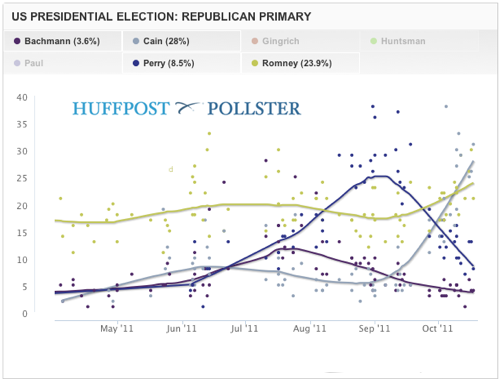
At first glance, the news coverage data in the Pew Research report doesn't seem to capture nearly as much volatility as the polling data. For example, a chart showing trends in the tone of each candidate's coverage, based on a computer analysis of more than 11,500 news outlets that publish stories on the Internet, reveals that the tone of stories about Cain has grown more positive in recent weeks, while those about Perry have grown less positive. That shift helps explain Perry's decline and Cain's recent ascent.
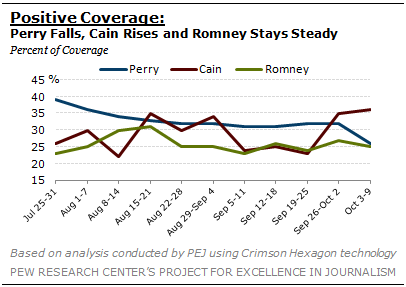
But as the chart also shows, Cain's coverage was equally positive in mid-August. Why no polling surge then? The answer is that, while the tone of Cain's coverage was more positive in August, the total number of stories about Cain was still low. The numbers in the Pew Research chart above quantify the tone of coverage for each candidate rather than the amount of coverage. Of course, the level of coverage given each of the Republican candidates has varied considerably.
We know about this variation because the same Pew Research study also highlights a different set of data tracking the level of attention given each candidate, based on a manual analysis of a smaller subset of major news outlets. These data include statistics, tabulated on a monthly basis, that show how often each candidate was the primary focus of a news story.
We combined both sets of Pew data to produce rough estimates of the numbers of positive stories about each candidate each month as a percentage of all campaign coverage. As shown in the charts below, the correlation of these percentages to the rise and fall of the polling numbers for Bachmann, Perry and Cain is striking.
First, consider Bachmann. She experienced a sharp rise in positive coverage that peaked in July before her win in the straw poll in Ames, Iowa, and then faded. Her polling numbers show almost exactly the same pattern.
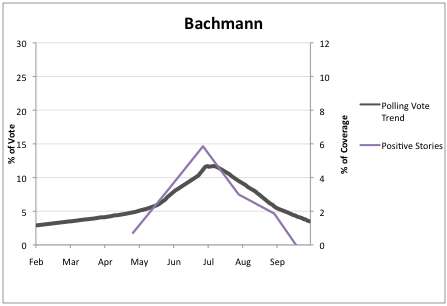
Perry saw a bigger surge and decline in positive coverage that coincided with a similarly large surge and decline in the polls.
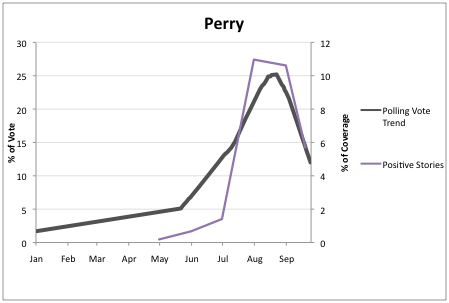
Cain's poll and positive coverage numbers show parallel upward trends. His polling numbers have increased at almost exactly the same rate as the approximate number of positive stories about him as a percentage of all campaign coverage.

What does this pattern imply about where Cain's numbers are headed? The data suggest that coverage of Cain need not turn negative for his support to fade. If the media's attention simply diminishes, if he "quietly disappear[s] from Fox News coverage," as blogger Jonathan Bernstein speculates, that absence alone will likely cause Cain's poll numbers to drop.
The trend has been far more stable in the polling support for Romney, but a decline in positive news coverage in August -- likely the result of the greater attention given Perry -- corresponded with a slight drop in Romney's poll numbers.
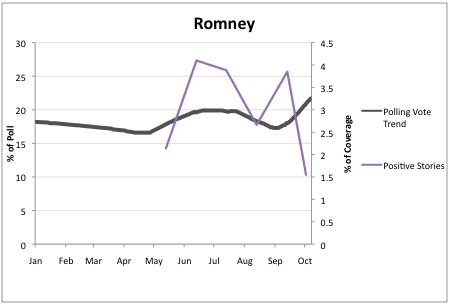
While positive news coverage boosts poll numbers, the opposite is also true: Poll results influence the media, as stories about the growing support for Bachmann, Perry and Cain have no doubt contributed to increasing amounts of positive news coverage. So a small rise in coverage can produce positive movement in poll stories, which in turn begets further increase in poll support. When a race lacks a dominant front-runner and when three out of four Republicans say they haven't made a final choice, the potential for this sort of coverage-based polling volatility is great.
The lesson here is about the limits of early trial-heat polling. What happened to the support recorded for Michele Bachmann in August and Rick Perry in September? Those poll numbers were no more than a snapshot of fleeting preferences, just as Herman Cain's current lead is likely to be fleeting, too.
